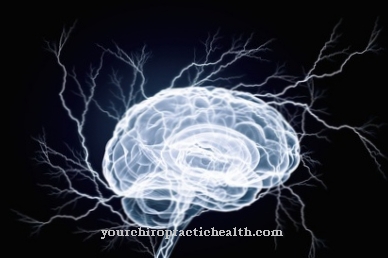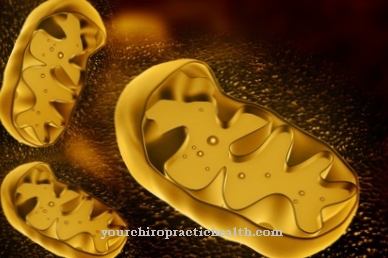Osmoregulation describes the equalization of the osmotic pressure within a living organism. It is based on osmosis: a biological process in which water diffuses through a semipermeable membrane. In the event of a biochemical imbalance, osmoregulation leads to the development of edema.
What is osmoregulation?

The osmotic regulation describes a biochemical process which aims to balance the concentration of dissolved substances within an organism. The membranes of living cells represent a so-called semipermeable (semi-permeable) surface. This means that they allow a partial exchange of liquid between the interior of the cell and its surroundings.
The osmoregulation has the task of creating a balanced and constant state. This balanced state is called homeostasis and refers both to the balance at the cellular level and to the balance between entire organs and their respective environment. An imbalance, on the other hand, creates osmotic pressure, which forces a balance on the basis of physical laws of nature.
Function & task
Osmoregulation follows two fundamental principles. When equalizing due to the concentration gradient, the water diffuses to the side of the membrane that has a higher concentration of a solute. For example, if a cell is in an environment that has a high concentration of salt, the water in the cell moves out of it due to the osmotic pressure and the cell loses fluid inside. This state lasts until the concentration gradient shifts, thus forcing a new balance: osmoregulation is a constant process that the human body cannot inhibit or promote.
The second working principle of osmosis is the balance due to the electrical charge. Electrically charged particles, so-called ions and anions, play an important role in the functioning of cells on a biochemical level. Ions have a positive electrical charge, while anions are negatively charged. Changes in voltage in the cell, for example, influence the nature of the membrane and thereby change its permeability for certain substances.
Osmoregulation aims for an identical electrical charge on both sides of the membrane. If, for example, a negative polarization prevails within a cell, this creates an osmotic pressure, as with concentration imbalance, and water diffuses into the cell. In extreme cases, excessive diffusion of water into the cell can lead to irreversible damage or even to its bursting. However, such an extreme condition is more than unlikely in the human body.
With the help of osmoregulation, the organism not only balances the ratio of dissolved substances inside and outside of individual cells, but also controls the diffusion for entire tissue structures on a macroscopic level.
The organ that is most important for the osmoregulation of the organism as a whole are the kidneys - because they determine the excretion of water in the form of urine. They are regulated by various hormones, including aldosterone and angiotensin II; the kidneys in turn produce hormones that influence numerous metabolic processes. They are also responsible for regulating the pH value of the blood, filtering and storing energy through glucose.
Illnesses & ailments
Osmoregulation plays a role in connection with various underlying diseases, for example in the development of edema. Edema is a swelling of the tissue caused by the increased retention of water. Excessive storage of fluid in the intercellular spaces (stroma), especially in the connective or supporting tissue, causes the characteristic swollen appearance of edema. However, the swellings can also manifest themselves hidden, for example in the brain, where they sometimes cause severe damage.
As a rule, edema does not occur in isolation, but is the result of another disease. Examples of this are kidney, liver or heart failure. The limited function of one of the organs mentioned has the consequence that undesired osmotic pressure arises in the tissue, which is not biologically intended in this form. Because of the automatic osmoregulation, water flows into the spaces between the cells; the lymphatic system cannot remove the excess fluid and the tissue swells. Depending on its severity and localization, the swelling can cause pain and limit mobility.
Hypoalbuminemia is an underlying disease due to which osmoregulation causes such symptoms. This is a deficiency in the protein albumin, which is the most common of all proteins in the human organism. Potential reasons for an albumin deficiency are poor diet, liver or kidney damage, and burns or acute inflammation. Hypoalbuminemia can also appear during pregnancy for physiological reasons.
The deficiency of the protein albumin leads to a change in the osmoregulation of the body: along the concentration gradient, water diffuses out of the blood plasma and collects in the known way in the intercellular spaces.
In developing countries, crisis areas and regions with insufficient food supply, hunger edema (Kwashiorkor) often appears as a special variant of hypoalbuminemia. His therapy consists essentially in the supply of protein-rich food to compensate for the lack of protein.
However, water retention is not necessarily the result of a serious illness. Excessive intake of salt through food also triggers the unwanted storage of fluids in the stroma. Taking diuretic medication can shift osmoregulation in favor of increased fluid excretion.













.jpg)

.jpg)
.jpg)











.jpg)